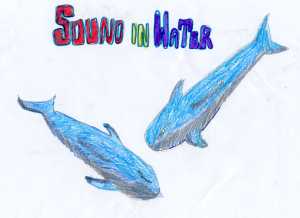
|
|

 Dolphins use echolocation to communicate, locate fish and detect underwater obstacles.
Echolocation is a loud clicking sound produced by dolphins.The clicking sound bounces off objects which causes an echo. Dolphins can communicate to each other hundreds of kilometres away from each other. Humans can hear millions of sounds, from screams to the hissing of a cat, but there are some sounds that are far too high-pitched for humans to hear. Some animals including dogs can hear these high-pitched signals. Whales use this method to see, by sending the signal against the sea-floor. It then bounces back to them, telling them where they are located. Some whales sing songs which can be heard throughout the oceans. A male humpback whale has it's own song which will last for 35 minutes. Fishermen used this method. If it was a foggy night and they couldn't see and they knew there were cliffs ahead they would shout out. An echo would come back to them. They would start counting after they shouted out. If it took 5 seconds they were one mile away, 10 seconds if they were two miles away etc.
Dolphins use echolocation to communicate, locate fish and detect underwater obstacles.
Echolocation is a loud clicking sound produced by dolphins.The clicking sound bounces off objects which causes an echo. Dolphins can communicate to each other hundreds of kilometres away from each other. Humans can hear millions of sounds, from screams to the hissing of a cat, but there are some sounds that are far too high-pitched for humans to hear. Some animals including dogs can hear these high-pitched signals. Whales use this method to see, by sending the signal against the sea-floor. It then bounces back to them, telling them where they are located. Some whales sing songs which can be heard throughout the oceans. A male humpback whale has it's own song which will last for 35 minutes. Fishermen used this method. If it was a foggy night and they couldn't see and they knew there were cliffs ahead they would shout out. An echo would come back to them. They would start counting after they shouted out. If it took 5 seconds they were one mile away, 10 seconds if they were two miles away etc.Dolphins produce clicking sounds from an organ called a melon on their head.
 Bats can fly in total darkness even though they can't see. They do this by screeching out a very high pitched note, but we cannot hear this high pitched sound and this sound is called ultrasonic sound. Hospitals use this method to see babies in a mother's womb. They send the signal into the mother's womb. It bounces off the baby and goes back out. The hospital then puts this picture on a special camera, allowing the family to see the baby.
Bats can fly in total darkness even though they can't see. They do this by screeching out a very high pitched note, but we cannot hear this high pitched sound and this sound is called ultrasonic sound. Hospitals use this method to see babies in a mother's womb. They send the signal into the mother's womb. It bounces off the baby and goes back out. The hospital then puts this picture on a special camera, allowing the family to see the baby.
Bats can hear up to 120,000 hertz. A young person can hear up to 20,000 hertz. Some notes and sounds are just too high for humans to hear.
Many animals can hear a lot more than humans:
| Animals | Hertz |
| Bats | Up to 120 000 |
| Mice | Up to 100 000 |
| Dogs | Up to 35 000 |
| Cats | Up to 25 000 |
| People | Up to 20 000 |